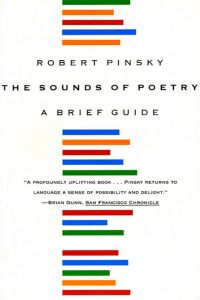 I first read Robert Pinsky’s The Sounds Of Poetry more than a decade ago, and in the intervening years have found no better guide to the music of verse. This little book was first published in 1998, while Pinsky was serving as Poet Laureate to the Library of Congress, and one of the chief duties of that position being the promotion of poetry, he discharged his responsibility with this excellent introduction to the technical structure of poetry. I have gone through it now, from cover to cover, three or four times, including once in a classroom setting, and have not yet managed to exhaust its insights or failed to rediscover some vital element of prosody to enrich my reading and heighten my appreciation.
I first read Robert Pinsky’s The Sounds Of Poetry more than a decade ago, and in the intervening years have found no better guide to the music of verse. This little book was first published in 1998, while Pinsky was serving as Poet Laureate to the Library of Congress, and one of the chief duties of that position being the promotion of poetry, he discharged his responsibility with this excellent introduction to the technical structure of poetry. I have gone through it now, from cover to cover, three or four times, including once in a classroom setting, and have not yet managed to exhaust its insights or failed to rediscover some vital element of prosody to enrich my reading and heighten my appreciation.
He begins, as any poet must, by awakening us to the sounds of our everyday language, so often overlooked and yet vitally necessary to successful communication. (Children born with hearing problems, for example, are often doubly cursed with delayed language development, because speech develops primarily from our ability to hear – and thereby emulate – the speech of others.) The unit of sound in English is the syllable, and though we all demonstrate the importance of syllables in everyday speech, we rarely stop to consider their function. Pinsky asks us to speak out loud the phrase “Permit me to give you a permit” – to correctly pronounce that sentence, you must grasp that there is a subtle vocal shift between two words of identical spelling. This brings him to his first insight, one that, once again, we all know intuitively, but rarely formulate into words: “the stress on a syllable in English is not inherent in the sound, but relative. A syllable is stressed or unstressed only in relation to the syllables around it.” The music of poetry, our sense of its rhythm, springs directly from these variations in stress; a good poet manipulates these variations for sonic effect. This is what Keats means when he enjoins poets to “inspect the lyre, and weigh the stress / Of every chord, and see what may be gain’d / By ear industrious, and attention meet.” After a basic outline of English meter, he points out another special aspect of syllables: their varying length. Consider the following monosyllabic words: it, ought, awed – they are arranged in ascending order of “duration,” a rough measure of the time it takes to sound out each word.
Satisfied that his reader now has a basic appreciation of syllables and their role in producing sound, he moves on to a discussion about the lines of poetry, and how they help to enforce – or undermine – the rhythms of the poem. If you have ever believed, as I have, that the line breaks in free verse poems were chosen arbitrarily, with no higher regard than the whim of the poet, this section in particular is worth close reading.
Adding to his insights are his close readings of famous poems, or famous lines from poetry, to reveal how they exemplify some special technique or trick of prosody, and often he will return to the same poem multiple times, mining old lines for new insights and revealing the consummate craftsmanship with which poets like Shakespeare and Frost, Wallace Stevens and Elizabeth Bishop practiced their art. The Sounds Of Poetry is a short, dense and above all loving introduction to the art of poetry, from a modern practitioner and lifelong devotee.